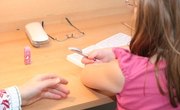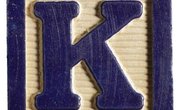Syllables, also known as word chunks, are letters or groups of letters that make one sound. Some words contain only one syllable, while others contain multiple syllables. Teaching children to discover syllables will aid them in both reading and spelling. There are many rules in learning about syllables, but with adequate teaching and review, the students will be able to master the concept quickly.
Teaching Syllables
Teaching syllables to young children or English language learners can actually be a fun concept. By using different strategies like clapping, flashcards and listening to vowel sounds when using examples of syllables, there are many things teachers can do to help their students understand.
Explain "Chunking" With Clapping
Explain that words are broken into chunks called syllables. One of the best ways to explain syllables is by using clapping. For example, saying the word "cat" and then clapping on the syllable. "Cat" has one syllable. Demonstrate again using the word "elephant" -- el (clap), e (clap), phant (clap). Say random words, and have the students clap out the syllables with you. Once students understand the concept, move on to explaining the rules of dividing words into syllables.
Review Vowel Sounds in Words
Before you start teaching syllables, may be a good idea to review short and long vowel sounds with students, and even have them posted up somewhere on the classroom wall as a quick reference. You should also introduce vowel-team syllables, which are vowels that are placed together to produce a new sound, such as “ie” and “au.” These are also known as special sounds. Write the following examples on the board: “chief,” “fau-cet,” and “a-bout.”
Once you've reviewed this, it's time to get into how these vowel sounds apply to syllable rules. Explain that each syllable can only contain one vowel sound. This does not mean that a syllable can only contain one vowel. Often, two or more vowels are placed together to make one vowel sound (i.e. “bread”). Ensure they understand that while “bread” has two vowels, only the "e" sound can be heard.
Introduce Closed Vs. Open Syllables
The true first step in understanding syllables is recognizing that there are different types of syllables. Inform the students that a closed syllable ends with a consonant and contains a short-vowel sound and an open syllable ends with a long-vowel sound. Make two sections on the board for each type, with "Closed Syllables" on one side and "Open Syllables" on another.
Under the "Closed Syllable" section, write the following examples on the board: “pet,” “dog” and “ap-ple" and explain that the "et" in "pet," the "og" in "dog" and the "ap" in "apple" are short vowel sounds that end in consonants. It may be helpful to underline the short vowel sound, and circle the consonant that follows. Reiterate that these are closed syllables.
Next, introduce open syllables and how each ends with a long-vowel sound. Write the following examples on the board: “a-pron,” “pro-gram,” and “e-vent.” Explain that in these examples, the "a" in "apron" is a long "a" sound, the "o" in "program is a long "o" sound and the "e" in "event" is a long "e" sound. Circle the sound to indicate that it marks the end of the syllable, and reiterate that these are open syllables.
Discuss the Silent "E"
Describe that the consonant-vowel-consonant-e (or, CVC-E words) is a type of syllable in a word which contains silent “e.” Write the following examples on the board: “make” “care” and “lake." Write a "c" over the first consonant, a "v" over the vowel, a "c" over the third consonant and an down arrow pointing to the "e" over the silent "e." Explain that even though there is another vowel in this word (the "e") that since it is silent, there is technically only one vowel sound in each of these words.
Describe the "Le" Syllable
Explain that a consonant-le syllable is just as its name implies. It is a syllable containing a consonant followed by “le.” Write the following examples on the board: “han-dle,” “bea-gle,” and “bi-cy-cle.” Often the natural tendency when sounding out these words is to separate the final consonant from the “le” (i.e. “hand-le”). Reinforcement of this rule will help students to remember the proper place to divide the word.
Describe Double Consonants
Inform students that any word containing a double consonant should be divided between those consonants. Middle should be “mid-dle.” Little should be “lit-tle.” Giggle should be “gig-gle.” Point out that this corresponds with the previous rule.
Instruct Students About "R"-Controlled Syllables
Instruct the students that an r-controlled syllable is one that contains a vowel followed by the letter “r” and therefore producing a different sound (ar, er, ir, or, and ur). Write the following examples on the board: “car,” “part-ner,” and “girl-friend.”
Review Suffixes as Syllables
Review suffixes, which are letters or groups of letters that can be added to the end of an existing word to form a new word (i.e. -ing, -ly, -er). Inform the students that most suffixes are syllables in and of themselves and should be separated from the root word as such. Write the following examples on the board: “slow-ly,” “lick-ing,” and “tight-er.”
Related Articles
References
Writer Bio
This article was written by the CareerTrend team, copy edited and fact checked through a multi-point auditing system, in efforts to ensure our readers only receive the best information. To submit your questions or ideas, or to simply learn more about CareerTrend, contact us [here](http://careertrend.com/about-us).









